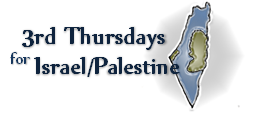Support freedom of movement, not occupation
Over the next few days thousands of visitors from around the world will begin arriving in Bethlehem for the celebration of Christmas. On December 22 a joint simulcast worship service will take place between the Christmas Lutheran Church in Bethlehem and the National Cathedral in Washington, D.C. And on Christmas Eve the eyes of the world will focus on the city as the celebration held in Manger Square and the midnight mass at the church of the Nativity are broadcast to the world. On Christmas day the thoughts of even more people will briefly turn towards Bethlehem as Jesus’ birth in the city and the promise of transformation, reconciliation, and peace are commemorated.
However, in the Bethlehem District after the visitors have left and the Christmas decorations have been taken down a stark modern day reality will surface. The charter buses used to ferry foreign guests to and from the city will have passed smoothly through the massive steel gates in the wall that separates Jerusalem from Bethlehem, and Christmas visitors will have felt little impact from the closure imposed over the city. However, Palestinian movement into and out of the city remains restricted and those Palestinians given permission to move between Jerusalem and Bethlehem are forced to queue for hours as they wait to pass through the crowded tunnels and turnstiles contained in the terminal hidden just out of sight of the tourists. This is the stark reality to which Palestinians will awake on December 26, and every day.
Equally hidden will be the destruction that has resulted from the construction of the wall on the land of other Bethlehem area communities like Al Walaja, Wadi Fukin, Battir, Husan, and Beit Safafa. In the area of these villages the wall diverges significantly from the Green Line — the formal boundary between the West Bank and Israel — in order to keep Israeli settlements on the western side of the wall. The villagers – who are mostly farmers – will be cut off from their farm land and will have only restricted access to the hospitals, schools, clinics, and stores in the towns of Beit Jala and Bethlehem. Residents of the villages will also be required to apply for permits from the Israeli military in order to remain in their homes and on their land.
Learn more about movement restrictions in Palestine here.
Similar stories can be told about other communities located all along the route of the wall as well as communities deep inside the West Bank which remain isolated as a result of Israeli imposed movement restrictions. While free movement between major West Bank cities has eased somewhat this year, according to the United Nations Office for the Coordination of Humanitarian Affairs at least 55 West Bank communities remain isolated as a result of roadblocks, barriers, checkpoints and other movement restrictions, and the number of obstacles to movement inside the West Bank increased to 542 during 2013 from 529 in 2012. Finally, movement between different parts of the occupied Palestinian territory (Gaza, East Jerusalem, and the West Bank) remains tightly controlled and Gaza remains under siege with most of its population denied the right to travel.
This situation must end. Tell your elected leaders you want U.S. policy that supports freedom, not occupation.
Click here to contact your senators and representative. Ask them to support U.S. policy that works for an end to the Israeli occupation and full freedom of movement and access for all Palestinians. Let them know that you believe Israel’s security rests not in controlling the Palestinian population, but in respecting equal freedom for all persons.

